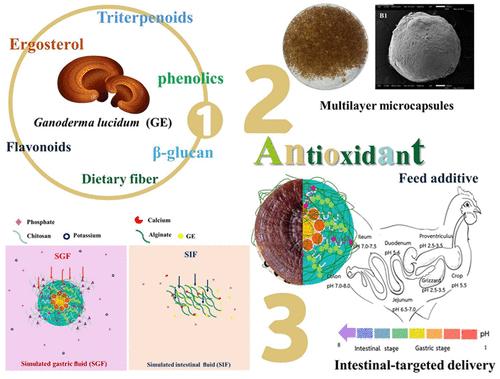Microencapsulation of Ganoderma lucidum Extract: Evaluation of Functional Components, In Vitro Simulated Digestion, and Stability as a Potential Feed Antioxidant
IF 2.6
Q2 FOOD SCIENCE & TECHNOLOGY
引用次数: 0
Abstract
Ganoderma lucidum extract (GE) exhibited excellent antioxidant activity with a diverse range of bioactive constituents for enhancing the antioxidant status in animals. However, the challenge is intestinal-targeted delivery. Microencapsulation is widely employed to protect pharmacological substances by fabricating microcapsules. This study investigated the preparation of multilayer microcapsules. Sodium alginate (SA) was used as the primary wall followed by the creation of polyelectrolyte multilayers using chitosan (CS)-SA to obtain GE/SA-CS. GE had high levels of ergosterol, flavonoids, and triterpenoids as well as >80% of antioxidant properties. In vitro simulated digestion indicated that the multilayers of SA-CS displayed a great controlled release ability under intestinal conditions (82.15 ± 3.99%). SA-CS not only protected the constituents of GE from acid, bile, trypsin, and heat treatment but also extended the storage shelf life of GE. Thus, the development of microencapsulation based on the antioxidant delivery system in multilayer SA-CS microcapsules could retain active compounds in GE.

灵芝提取物的微胶囊化:功能成分、体外模拟消化和作为潜在饲料抗氧化剂的稳定性评估
灵芝提取物(GE)具有出色的抗氧化活性,其多种生物活性成分可提高动物的抗氧化能力。然而,肠道靶向给药是一项挑战。微胶囊技术被广泛应用于通过制造微胶囊来保护药效物质。本研究探讨了多层微胶囊的制备。首先使用海藻酸钠(SA)作为主壁,然后使用壳聚糖(CS)-SA 制造聚电解质多层膜,得到 GE/SA-CS。GE 中含有大量麦角甾醇、类黄酮和三萜类化合物,并具有 80% 的抗氧化性。体外模拟消化表明,SA-CS 多层膜在肠道条件下具有很强的控释能力(82.15 ± 3.99%)。SA-CS 不仅能保护 GE 成分免受酸、胆汁、胰蛋白酶和热处理的影响,还能延长 GE 的贮藏保质期。因此,基于多层 SA-CS 微胶囊中的抗氧化剂输送系统开发的微胶囊技术可以保留 GE 中的活性化合物。
本文章由计算机程序翻译,如有差异,请以英文原文为准。
求助全文
约1分钟内获得全文
求助全文

 求助内容:
求助内容: 应助结果提醒方式:
应助结果提醒方式:


